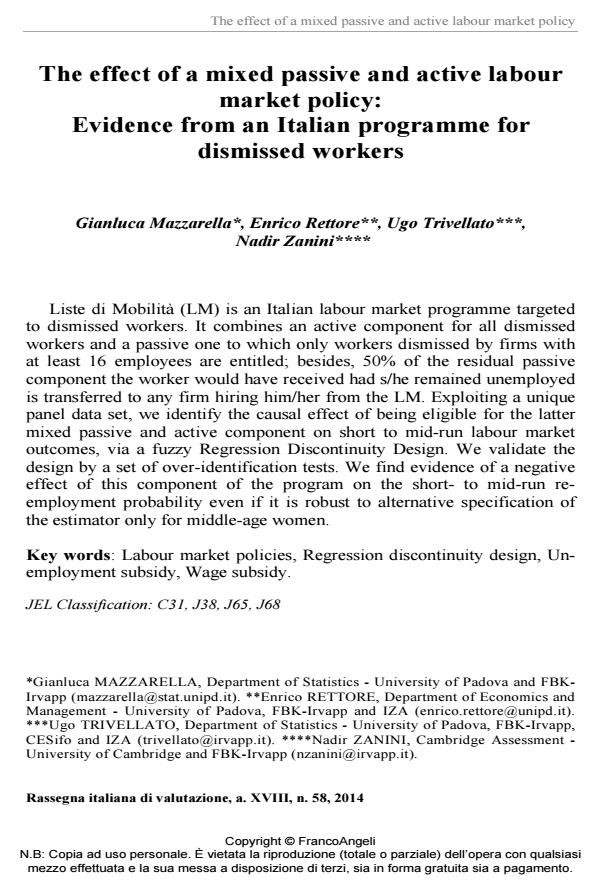The effect of a mixed passive and active labour market policy: Evidence from an Italian programme for dismissed workers
Journal title RIV Rassegna Italiana di Valutazione
Author/s Gianluca Mazzarella, Enrico Rettore, Ugo Trivellato, Nadir Zanini
Publishing Year 2015 Issue 2014/58 Language English
Pages 22 P. 80-101 File size 336 KB
DOI 10.3280/RIV2014-058005
DOI is like a bar code for intellectual property: to have more infomation
click here
Below, you can see the article first page
If you want to buy this article in PDF format, you can do it, following the instructions to buy download credits

FrancoAngeli is member of Publishers International Linking Association, Inc (PILA), a not-for-profit association which run the CrossRef service enabling links to and from online scholarly content.
Liste di Mobilità (LM) is an Italian labour market programme targeted to dismissed workers. It combines an active component for all dismissed workers and a passive one to which only workers dismissed by firms with at least 16 employees are entitled; besides, 50% of the residual passive component the worker would have received had s/he remained unemployed is transferred to any firm hiring him/her from the LM. Exploiting a unique panel data set, we identify the causal effect of being eligible for the latter mixed passive and active component on short to mid-run labour market outcomes, via a fuzzy Regression Discontinuity Design. We validate the design by a set of over-identification tests. We find evidence of a negative effect of this component of the program on the short- to mid-run reemployment probability even if it is robust to alternative specification of the estimator only for middle-age women.
Keywords: Labour market policies, Regression discontinuity design, Unemployment subsidy, Wage subsidy.
Jel codes: C31, J38, J65, J68
- Battistin, E., Brugiavini, A., Rettore, E. and Weber, G. (2009). The retirement consumption puzzle: Evidence from a regression discontinuity approach. The American Economic Review, 99 (5): 2209-2226. DOI: 10.1257/aer.99.5.220
- Brunello, G. and Miniaci, R. (2001). Benefit transfers in Italy: An empirical study of mobility lists in the Milan area. Oxford Bulletin of Economics and Statistics, 59 (3): 329-347. DOI: 10.1111/1468-0084.0006
- Caruso, E. and Pisauro, G. (2005). Licenziamenti definitivi o temporanei? Durata della disoccupazione nelle Liste di mobilità tra nuovi e vecchi datori di lavoro. Politica economica, 21 (3): 361-400. DOI: 10.1429/2082
- Ham, J. and LaLonde, R. (1996). The effect of sample selection and initial conditions in duration models: Evidence from experimental data on training. Econometrica, 64 (1): 175-
- 205. DOI: 10.2307/2171928Lee,D.(2008).Randomizedexperimentsfromnon-randomselectioninU.S.Houseelections.JournalofEconometrics,142(2):675-697.DOI:10.1016/j.econom.2007.05.00
- Lee, D. and Lemieux, T. (2010). Regression Discontinuity Designs in economics. Journal of Economic Literature, 48 (2): 281-355. DOI: 10.1257/jel.48.2.28
- Martini, A. and Mo Costabella, L. (2007). Una valutazione degli effetti indesiderati dell'istituto della mobilità su imprese e lavoratori. Politica Economica, 23 (3): 259-288. DOI: 10.1429/2571
- Maurizio, D. and Trevisan, E. (2009). Giove-VWH: Esperienza di linkage tra data base amministrativi. Progetto MIUR ‘Metodi e studi di valutazione degli effetti di politiche del lavoro, di aiuto alle imprese e di welfare’, Working Paper No. 78, Padova: Dipartimento di Scienze Statistiche, Università di Padova. Available at: http://valutazione2003.stat.unipd.it/pdf/wp/WP_78.pdf
- McCrary, J. (2008). Manipulation of the running variable in the regression discontinuity design: A density test, Journal of Econometrics, 142 (2): 698-714. DOI: 10.1016/j.jeconom.2007.05.00
- Mortensen, D.T. and Pissarides, C.A. (1999). New developments in models of search in the labor market. In: Ashenfelter, O.C. and Card, D. Handbook of Labor Economics. Vol. 3C. Amsterdam: Elsevier. DOI: 10.1016/S1573-4463(99)30025-
- Paggiaro, A. and Trivellato, U. (2002). Assessing the effects of the ‘Mobility Lists’ programme by flexible duration models. Labour, 16 (2): 235-266. DOI: 10.1111/1467-9914.0019
- Paggiaro, A., Rettore, E. and Trivellato, U. (2005). The impact of the Italian ‘Mobility Lists’ on employment chances: New evidence from linked administrative archives. Progetto MIUR ‘Metodi e studi di valutazione degli effetti di politiche del lavoro, di aiuto alle imprese e di welfare’, Working Paper No. 65. Padova: Dipartimento di Scienze Statistiche, Università di Padova. Available at: http://valutazione2003.stat.unipd.it/pdf/wp/WP_65.pdf
- (2009). The effect of a longer eligibility to a labour market programme for dismissed workers. Labour, 23 (1): 37-66. DOI: 10.1111/j.1467-9914.2008.00446.
- Rettore, E., Paggiaro, A. and Trivellato, U. (2008). The effect of extended duration of eligibility in an Italian labour market for dismissed workers, Discussion Paper No. 3633. Bonn: IZA. Available at: http://ftp.iza.org/dp3633.pdf
- Snower D. (1994). Converting unemployment benefits into employment subsidies. American Economic Review, 84 (2): 65-70.
Gianluca Mazzarella, Enrico Rettore, Ugo Trivellato, Nadir Zanini, The effect of a mixed passive and active labour market policy: Evidence from an Italian programme for dismissed workers in "RIV Rassegna Italiana di Valutazione" 58/2014, pp 80-101, DOI: 10.3280/RIV2014-058005